A Report on Waste Management and Sustainability at ASDA Supermarket
VerifiedAdded on 2023/01/13
|15
|5088
|47
Report
AI Summary
This report provides a detailed examination of ASDA Supermarket's waste management practices in the UK, focusing on its sustainability initiatives. The introduction establishes the context of sustainability and its three pillars: economic, environmental, and social, highlighting ASDA's role as a retail sector organization. The main body delves into various waste management strategies, including waste hierarchy, reuse, packaging, re-manufacturing, repair, recycling, and e-waste management. It explores the environmental, financial, and social benefits of each practice, such as reducing carbon footprint, lowering operational costs, and increasing employee awareness. The report also analyzes ASDA's adoption of the circular economy process and the challenges associated with different waste management techniques. Finally, the conclusion summarizes the key findings and recommendations for enhancing ASDA's sustainability efforts. The report emphasizes the importance of waste management in achieving environmental goals, reducing costs, and promoting social responsibility within the organization.
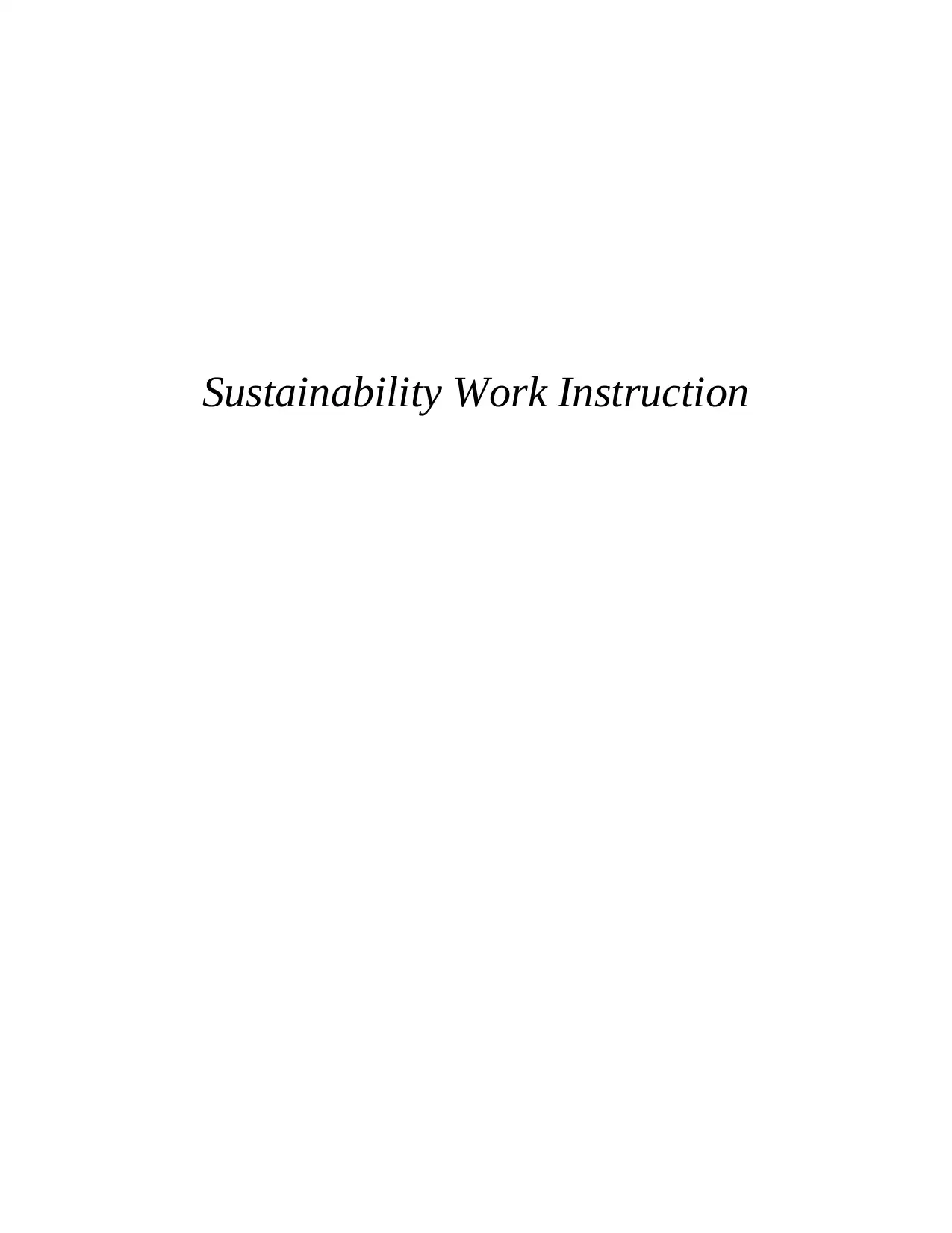
Sustainability Work Instruction
Paraphrase This Document
Need a fresh take? Get an instant paraphrase of this document with our AI Paraphraser
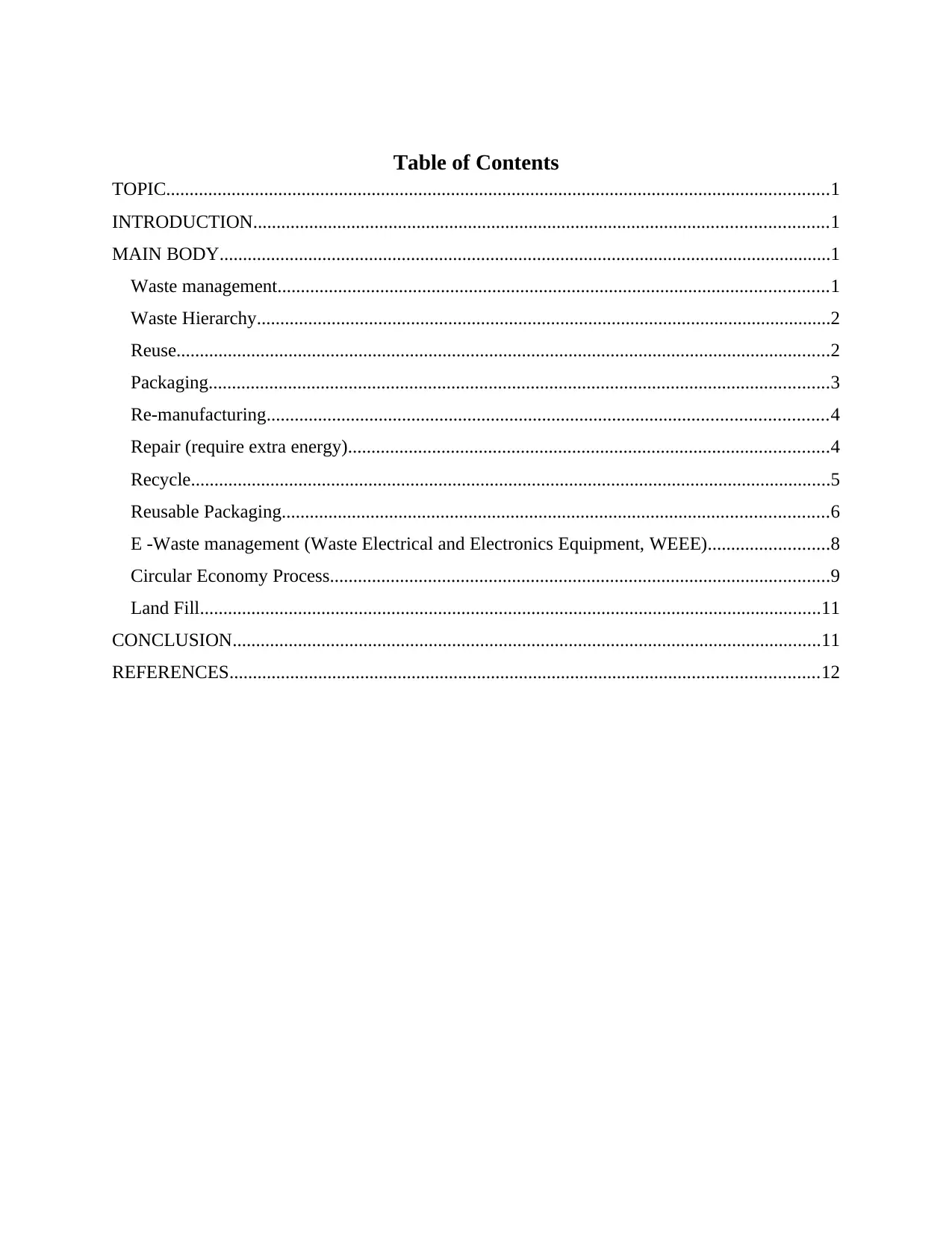
Table of Contents
TOPIC..............................................................................................................................................1
INTRODUCTION...........................................................................................................................1
MAIN BODY...................................................................................................................................1
Waste management......................................................................................................................1
Waste Hierarchy...........................................................................................................................2
Reuse............................................................................................................................................2
Packaging.....................................................................................................................................3
Re-manufacturing........................................................................................................................4
Repair (require extra energy).......................................................................................................4
Recycle.........................................................................................................................................5
Reusable Packaging.....................................................................................................................6
E -Waste management (Waste Electrical and Electronics Equipment, WEEE)..........................8
Circular Economy Process...........................................................................................................9
Land Fill.....................................................................................................................................11
CONCLUSION..............................................................................................................................11
REFERENCES..............................................................................................................................12
TOPIC..............................................................................................................................................1
INTRODUCTION...........................................................................................................................1
MAIN BODY...................................................................................................................................1
Waste management......................................................................................................................1
Waste Hierarchy...........................................................................................................................2
Reuse............................................................................................................................................2
Packaging.....................................................................................................................................3
Re-manufacturing........................................................................................................................4
Repair (require extra energy).......................................................................................................4
Recycle.........................................................................................................................................5
Reusable Packaging.....................................................................................................................6
E -Waste management (Waste Electrical and Electronics Equipment, WEEE)..........................8
Circular Economy Process...........................................................................................................9
Land Fill.....................................................................................................................................11
CONCLUSION..............................................................................................................................11
REFERENCES..............................................................................................................................12
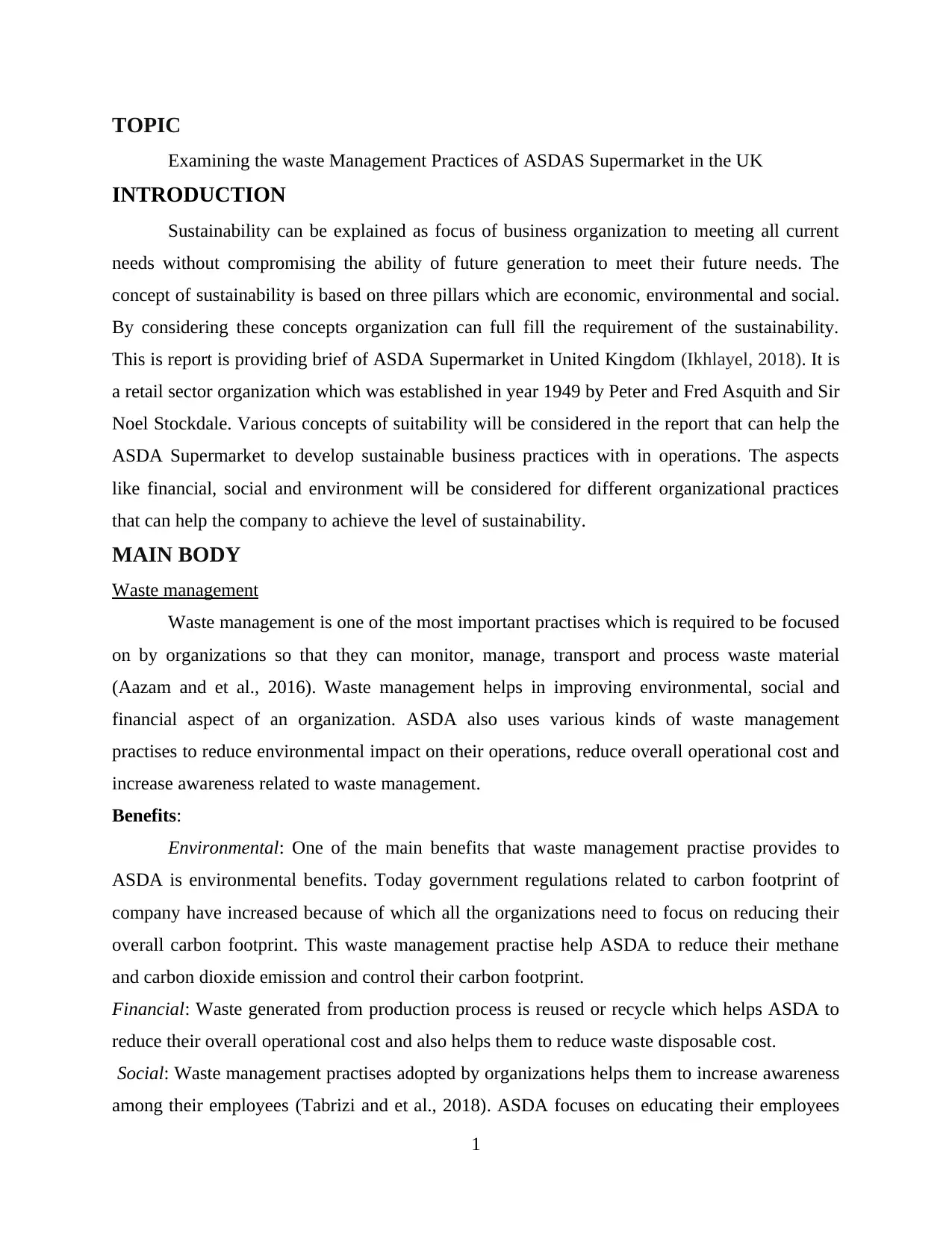
TOPIC
Examining the waste Management Practices of ASDAS Supermarket in the UK
INTRODUCTION
Sustainability can be explained as focus of business organization to meeting all current
needs without compromising the ability of future generation to meet their future needs. The
concept of sustainability is based on three pillars which are economic, environmental and social.
By considering these concepts organization can full fill the requirement of the sustainability.
This is report is providing brief of ASDA Supermarket in United Kingdom (Ikhlayel, 2018). It is
a retail sector organization which was established in year 1949 by Peter and Fred Asquith and Sir
Noel Stockdale. Various concepts of suitability will be considered in the report that can help the
ASDA Supermarket to develop sustainable business practices with in operations. The aspects
like financial, social and environment will be considered for different organizational practices
that can help the company to achieve the level of sustainability.
MAIN BODY
Waste management
Waste management is one of the most important practises which is required to be focused
on by organizations so that they can monitor, manage, transport and process waste material
(Aazam and et al., 2016). Waste management helps in improving environmental, social and
financial aspect of an organization. ASDA also uses various kinds of waste management
practises to reduce environmental impact on their operations, reduce overall operational cost and
increase awareness related to waste management.
Benefits:
Environmental: One of the main benefits that waste management practise provides to
ASDA is environmental benefits. Today government regulations related to carbon footprint of
company have increased because of which all the organizations need to focus on reducing their
overall carbon footprint. This waste management practise help ASDA to reduce their methane
and carbon dioxide emission and control their carbon footprint.
Financial: Waste generated from production process is reused or recycle which helps ASDA to
reduce their overall operational cost and also helps them to reduce waste disposable cost.
Social: Waste management practises adopted by organizations helps them to increase awareness
among their employees (Tabrizi and et al., 2018). ASDA focuses on educating their employees
1
Examining the waste Management Practices of ASDAS Supermarket in the UK
INTRODUCTION
Sustainability can be explained as focus of business organization to meeting all current
needs without compromising the ability of future generation to meet their future needs. The
concept of sustainability is based on three pillars which are economic, environmental and social.
By considering these concepts organization can full fill the requirement of the sustainability.
This is report is providing brief of ASDA Supermarket in United Kingdom (Ikhlayel, 2018). It is
a retail sector organization which was established in year 1949 by Peter and Fred Asquith and Sir
Noel Stockdale. Various concepts of suitability will be considered in the report that can help the
ASDA Supermarket to develop sustainable business practices with in operations. The aspects
like financial, social and environment will be considered for different organizational practices
that can help the company to achieve the level of sustainability.
MAIN BODY
Waste management
Waste management is one of the most important practises which is required to be focused
on by organizations so that they can monitor, manage, transport and process waste material
(Aazam and et al., 2016). Waste management helps in improving environmental, social and
financial aspect of an organization. ASDA also uses various kinds of waste management
practises to reduce environmental impact on their operations, reduce overall operational cost and
increase awareness related to waste management.
Benefits:
Environmental: One of the main benefits that waste management practise provides to
ASDA is environmental benefits. Today government regulations related to carbon footprint of
company have increased because of which all the organizations need to focus on reducing their
overall carbon footprint. This waste management practise help ASDA to reduce their methane
and carbon dioxide emission and control their carbon footprint.
Financial: Waste generated from production process is reused or recycle which helps ASDA to
reduce their overall operational cost and also helps them to reduce waste disposable cost.
Social: Waste management practises adopted by organizations helps them to increase awareness
among their employees (Tabrizi and et al., 2018). ASDA focuses on educating their employees
1
⊘ This is a preview!⊘
Do you want full access?
Subscribe today to unlock all pages.

Trusted by 1+ million students worldwide
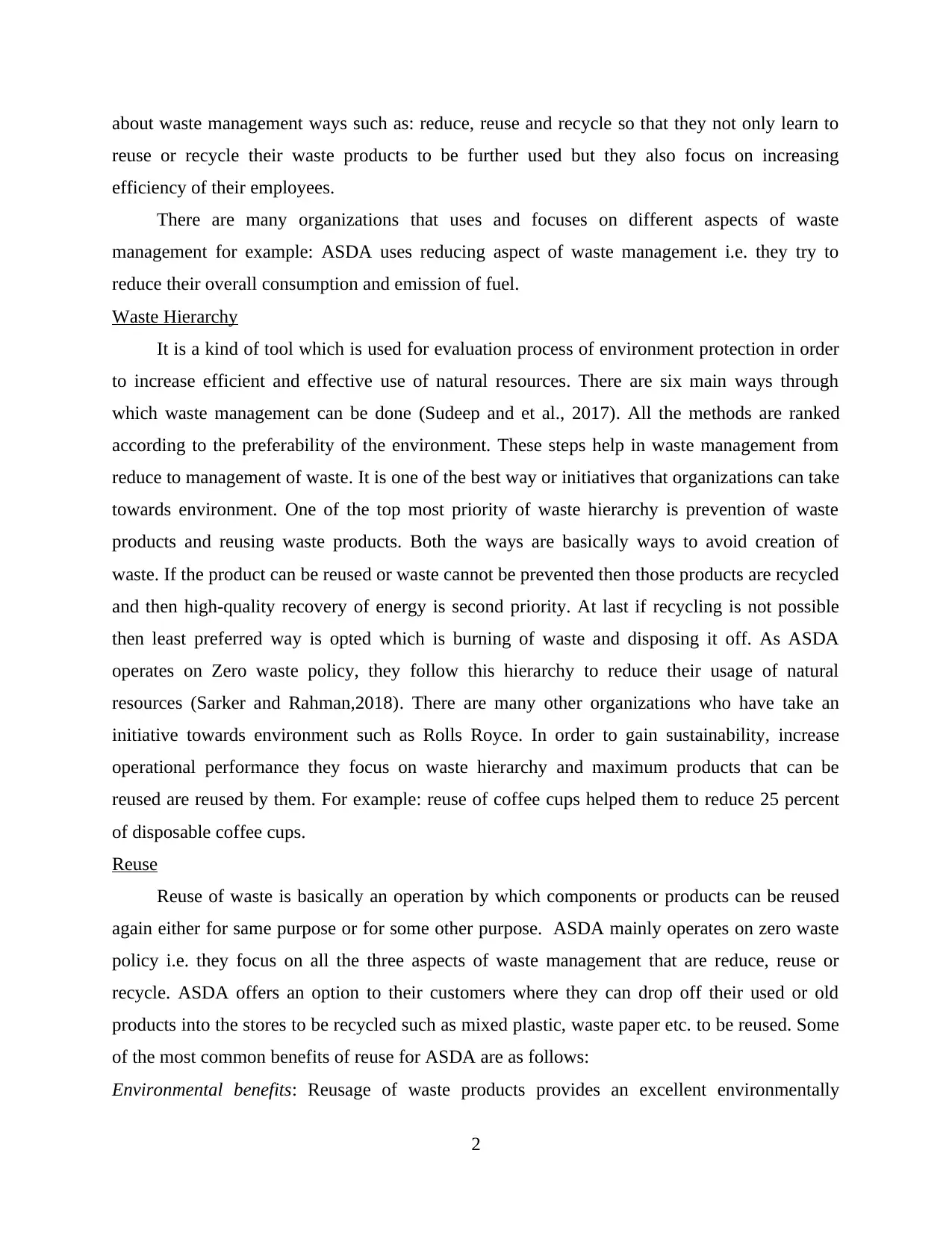
about waste management ways such as: reduce, reuse and recycle so that they not only learn to
reuse or recycle their waste products to be further used but they also focus on increasing
efficiency of their employees.
There are many organizations that uses and focuses on different aspects of waste
management for example: ASDA uses reducing aspect of waste management i.e. they try to
reduce their overall consumption and emission of fuel.
Waste Hierarchy
It is a kind of tool which is used for evaluation process of environment protection in order
to increase efficient and effective use of natural resources. There are six main ways through
which waste management can be done (Sudeep and et al., 2017). All the methods are ranked
according to the preferability of the environment. These steps help in waste management from
reduce to management of waste. It is one of the best way or initiatives that organizations can take
towards environment. One of the top most priority of waste hierarchy is prevention of waste
products and reusing waste products. Both the ways are basically ways to avoid creation of
waste. If the product can be reused or waste cannot be prevented then those products are recycled
and then high-quality recovery of energy is second priority. At last if recycling is not possible
then least preferred way is opted which is burning of waste and disposing it off. As ASDA
operates on Zero waste policy, they follow this hierarchy to reduce their usage of natural
resources (Sarker and Rahman,2018). There are many other organizations who have take an
initiative towards environment such as Rolls Royce. In order to gain sustainability, increase
operational performance they focus on waste hierarchy and maximum products that can be
reused are reused by them. For example: reuse of coffee cups helped them to reduce 25 percent
of disposable coffee cups.
Reuse
Reuse of waste is basically an operation by which components or products can be reused
again either for same purpose or for some other purpose. ASDA mainly operates on zero waste
policy i.e. they focus on all the three aspects of waste management that are reduce, reuse or
recycle. ASDA offers an option to their customers where they can drop off their used or old
products into the stores to be recycled such as mixed plastic, waste paper etc. to be reused. Some
of the most common benefits of reuse for ASDA are as follows:
Environmental benefits: Reusage of waste products provides an excellent environmentally
2
reuse or recycle their waste products to be further used but they also focus on increasing
efficiency of their employees.
There are many organizations that uses and focuses on different aspects of waste
management for example: ASDA uses reducing aspect of waste management i.e. they try to
reduce their overall consumption and emission of fuel.
Waste Hierarchy
It is a kind of tool which is used for evaluation process of environment protection in order
to increase efficient and effective use of natural resources. There are six main ways through
which waste management can be done (Sudeep and et al., 2017). All the methods are ranked
according to the preferability of the environment. These steps help in waste management from
reduce to management of waste. It is one of the best way or initiatives that organizations can take
towards environment. One of the top most priority of waste hierarchy is prevention of waste
products and reusing waste products. Both the ways are basically ways to avoid creation of
waste. If the product can be reused or waste cannot be prevented then those products are recycled
and then high-quality recovery of energy is second priority. At last if recycling is not possible
then least preferred way is opted which is burning of waste and disposing it off. As ASDA
operates on Zero waste policy, they follow this hierarchy to reduce their usage of natural
resources (Sarker and Rahman,2018). There are many other organizations who have take an
initiative towards environment such as Rolls Royce. In order to gain sustainability, increase
operational performance they focus on waste hierarchy and maximum products that can be
reused are reused by them. For example: reuse of coffee cups helped them to reduce 25 percent
of disposable coffee cups.
Reuse
Reuse of waste is basically an operation by which components or products can be reused
again either for same purpose or for some other purpose. ASDA mainly operates on zero waste
policy i.e. they focus on all the three aspects of waste management that are reduce, reuse or
recycle. ASDA offers an option to their customers where they can drop off their used or old
products into the stores to be recycled such as mixed plastic, waste paper etc. to be reused. Some
of the most common benefits of reuse for ASDA are as follows:
Environmental benefits: Reusage of waste products provides an excellent environmentally
2
Paraphrase This Document
Need a fresh take? Get an instant paraphrase of this document with our AI Paraphraser
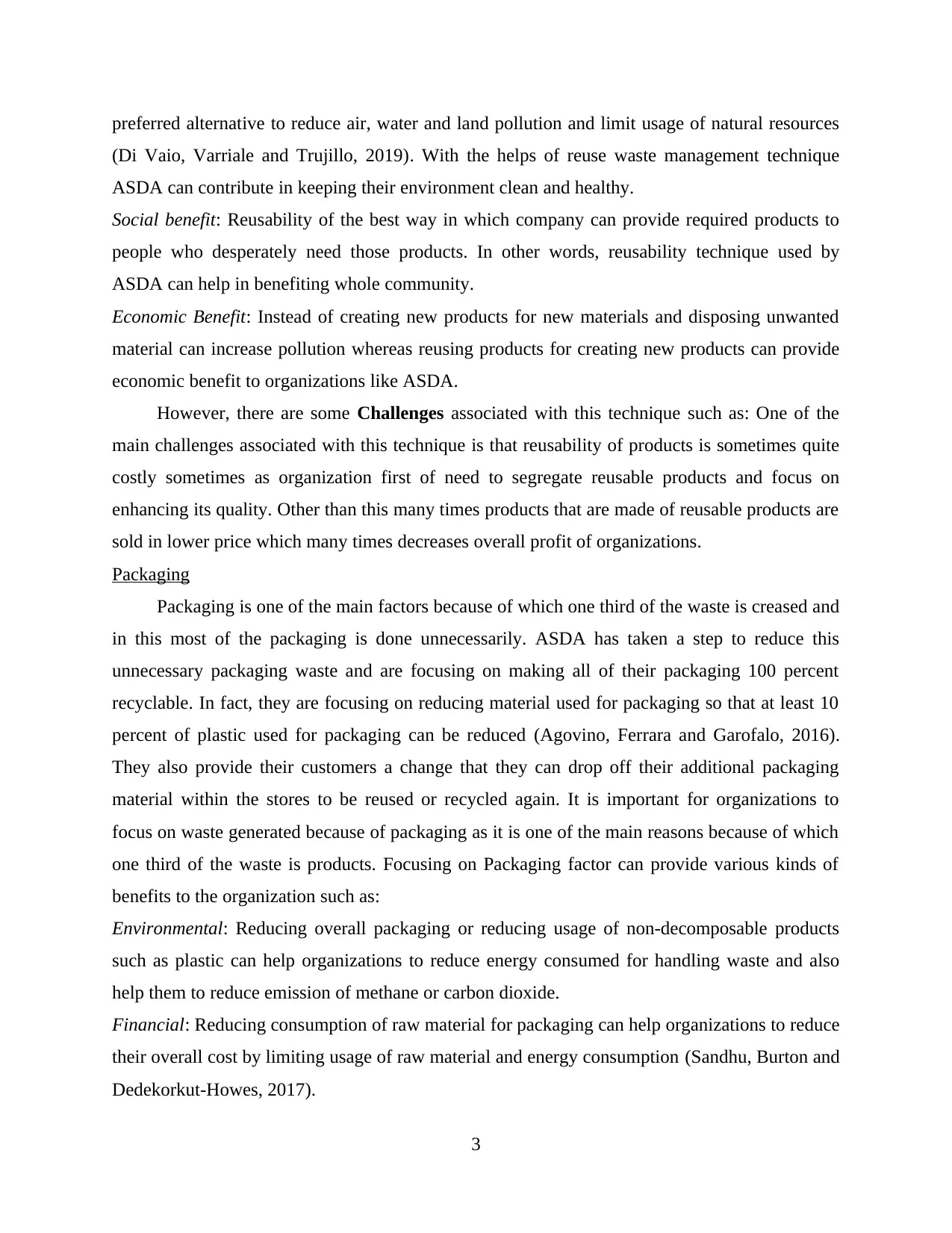
preferred alternative to reduce air, water and land pollution and limit usage of natural resources
(Di Vaio, Varriale and Trujillo, 2019). With the helps of reuse waste management technique
ASDA can contribute in keeping their environment clean and healthy.
Social benefit: Reusability of the best way in which company can provide required products to
people who desperately need those products. In other words, reusability technique used by
ASDA can help in benefiting whole community.
Economic Benefit: Instead of creating new products for new materials and disposing unwanted
material can increase pollution whereas reusing products for creating new products can provide
economic benefit to organizations like ASDA.
However, there are some Challenges associated with this technique such as: One of the
main challenges associated with this technique is that reusability of products is sometimes quite
costly sometimes as organization first of need to segregate reusable products and focus on
enhancing its quality. Other than this many times products that are made of reusable products are
sold in lower price which many times decreases overall profit of organizations.
Packaging
Packaging is one of the main factors because of which one third of the waste is creased and
in this most of the packaging is done unnecessarily. ASDA has taken a step to reduce this
unnecessary packaging waste and are focusing on making all of their packaging 100 percent
recyclable. In fact, they are focusing on reducing material used for packaging so that at least 10
percent of plastic used for packaging can be reduced (Agovino, Ferrara and Garofalo, 2016).
They also provide their customers a change that they can drop off their additional packaging
material within the stores to be reused or recycled again. It is important for organizations to
focus on waste generated because of packaging as it is one of the main reasons because of which
one third of the waste is products. Focusing on Packaging factor can provide various kinds of
benefits to the organization such as:
Environmental: Reducing overall packaging or reducing usage of non-decomposable products
such as plastic can help organizations to reduce energy consumed for handling waste and also
help them to reduce emission of methane or carbon dioxide.
Financial: Reducing consumption of raw material for packaging can help organizations to reduce
their overall cost by limiting usage of raw material and energy consumption (Sandhu, Burton and
Dedekorkut-Howes, 2017).
3
(Di Vaio, Varriale and Trujillo, 2019). With the helps of reuse waste management technique
ASDA can contribute in keeping their environment clean and healthy.
Social benefit: Reusability of the best way in which company can provide required products to
people who desperately need those products. In other words, reusability technique used by
ASDA can help in benefiting whole community.
Economic Benefit: Instead of creating new products for new materials and disposing unwanted
material can increase pollution whereas reusing products for creating new products can provide
economic benefit to organizations like ASDA.
However, there are some Challenges associated with this technique such as: One of the
main challenges associated with this technique is that reusability of products is sometimes quite
costly sometimes as organization first of need to segregate reusable products and focus on
enhancing its quality. Other than this many times products that are made of reusable products are
sold in lower price which many times decreases overall profit of organizations.
Packaging
Packaging is one of the main factors because of which one third of the waste is creased and
in this most of the packaging is done unnecessarily. ASDA has taken a step to reduce this
unnecessary packaging waste and are focusing on making all of their packaging 100 percent
recyclable. In fact, they are focusing on reducing material used for packaging so that at least 10
percent of plastic used for packaging can be reduced (Agovino, Ferrara and Garofalo, 2016).
They also provide their customers a change that they can drop off their additional packaging
material within the stores to be reused or recycled again. It is important for organizations to
focus on waste generated because of packaging as it is one of the main reasons because of which
one third of the waste is products. Focusing on Packaging factor can provide various kinds of
benefits to the organization such as:
Environmental: Reducing overall packaging or reducing usage of non-decomposable products
such as plastic can help organizations to reduce energy consumed for handling waste and also
help them to reduce emission of methane or carbon dioxide.
Financial: Reducing consumption of raw material for packaging can help organizations to reduce
their overall cost by limiting usage of raw material and energy consumption (Sandhu, Burton and
Dedekorkut-Howes, 2017).
3
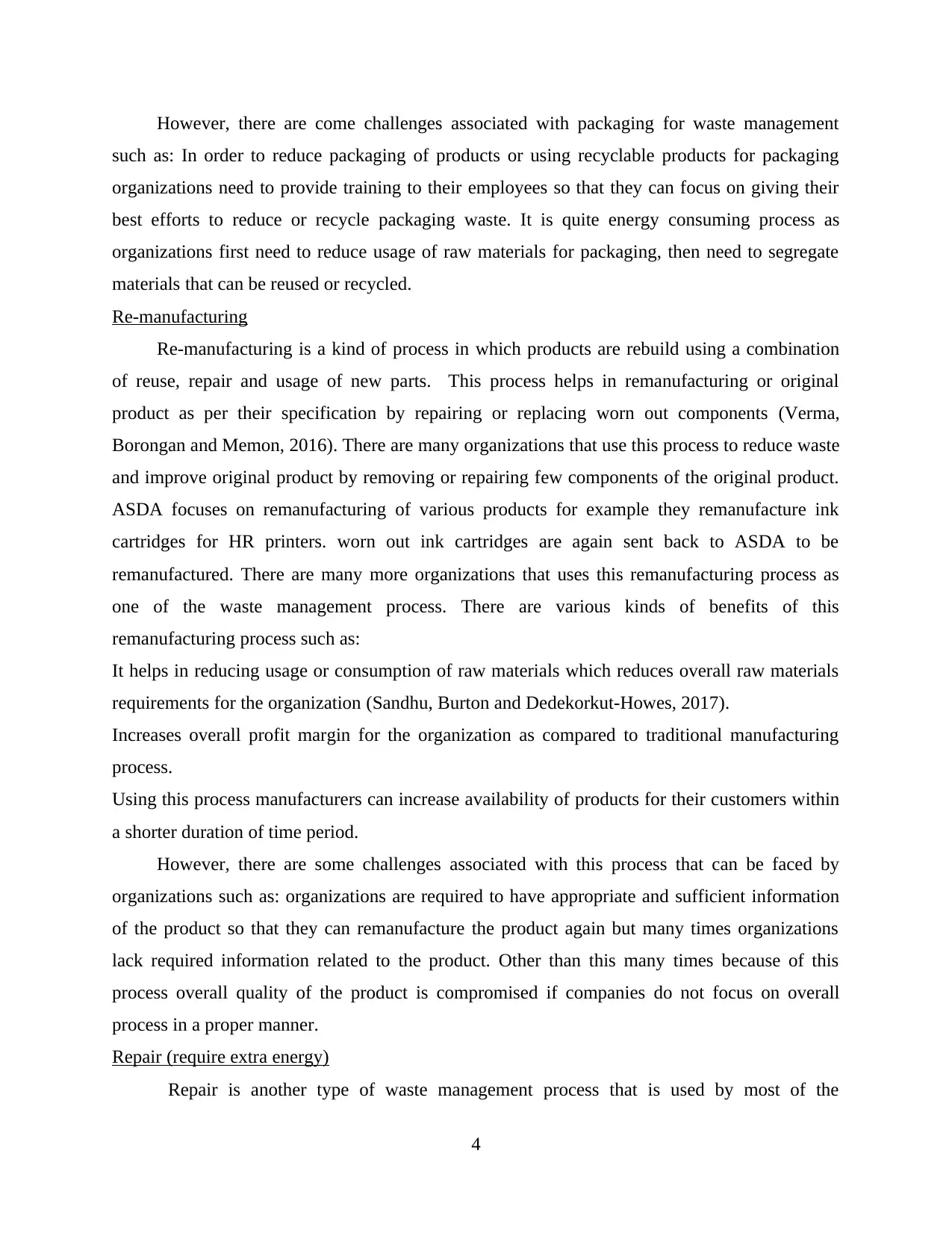
However, there are come challenges associated with packaging for waste management
such as: In order to reduce packaging of products or using recyclable products for packaging
organizations need to provide training to their employees so that they can focus on giving their
best efforts to reduce or recycle packaging waste. It is quite energy consuming process as
organizations first need to reduce usage of raw materials for packaging, then need to segregate
materials that can be reused or recycled.
Re-manufacturing
Re-manufacturing is a kind of process in which products are rebuild using a combination
of reuse, repair and usage of new parts. This process helps in remanufacturing or original
product as per their specification by repairing or replacing worn out components (Verma,
Borongan and Memon, 2016). There are many organizations that use this process to reduce waste
and improve original product by removing or repairing few components of the original product.
ASDA focuses on remanufacturing of various products for example they remanufacture ink
cartridges for HR printers. worn out ink cartridges are again sent back to ASDA to be
remanufactured. There are many more organizations that uses this remanufacturing process as
one of the waste management process. There are various kinds of benefits of this
remanufacturing process such as:
It helps in reducing usage or consumption of raw materials which reduces overall raw materials
requirements for the organization (Sandhu, Burton and Dedekorkut-Howes, 2017).
Increases overall profit margin for the organization as compared to traditional manufacturing
process.
Using this process manufacturers can increase availability of products for their customers within
a shorter duration of time period.
However, there are some challenges associated with this process that can be faced by
organizations such as: organizations are required to have appropriate and sufficient information
of the product so that they can remanufacture the product again but many times organizations
lack required information related to the product. Other than this many times because of this
process overall quality of the product is compromised if companies do not focus on overall
process in a proper manner.
Repair (require extra energy)
Repair is another type of waste management process that is used by most of the
4
such as: In order to reduce packaging of products or using recyclable products for packaging
organizations need to provide training to their employees so that they can focus on giving their
best efforts to reduce or recycle packaging waste. It is quite energy consuming process as
organizations first need to reduce usage of raw materials for packaging, then need to segregate
materials that can be reused or recycled.
Re-manufacturing
Re-manufacturing is a kind of process in which products are rebuild using a combination
of reuse, repair and usage of new parts. This process helps in remanufacturing or original
product as per their specification by repairing or replacing worn out components (Verma,
Borongan and Memon, 2016). There are many organizations that use this process to reduce waste
and improve original product by removing or repairing few components of the original product.
ASDA focuses on remanufacturing of various products for example they remanufacture ink
cartridges for HR printers. worn out ink cartridges are again sent back to ASDA to be
remanufactured. There are many more organizations that uses this remanufacturing process as
one of the waste management process. There are various kinds of benefits of this
remanufacturing process such as:
It helps in reducing usage or consumption of raw materials which reduces overall raw materials
requirements for the organization (Sandhu, Burton and Dedekorkut-Howes, 2017).
Increases overall profit margin for the organization as compared to traditional manufacturing
process.
Using this process manufacturers can increase availability of products for their customers within
a shorter duration of time period.
However, there are some challenges associated with this process that can be faced by
organizations such as: organizations are required to have appropriate and sufficient information
of the product so that they can remanufacture the product again but many times organizations
lack required information related to the product. Other than this many times because of this
process overall quality of the product is compromised if companies do not focus on overall
process in a proper manner.
Repair (require extra energy)
Repair is another type of waste management process that is used by most of the
4
⊘ This is a preview!⊘
Do you want full access?
Subscribe today to unlock all pages.

Trusted by 1+ million students worldwide
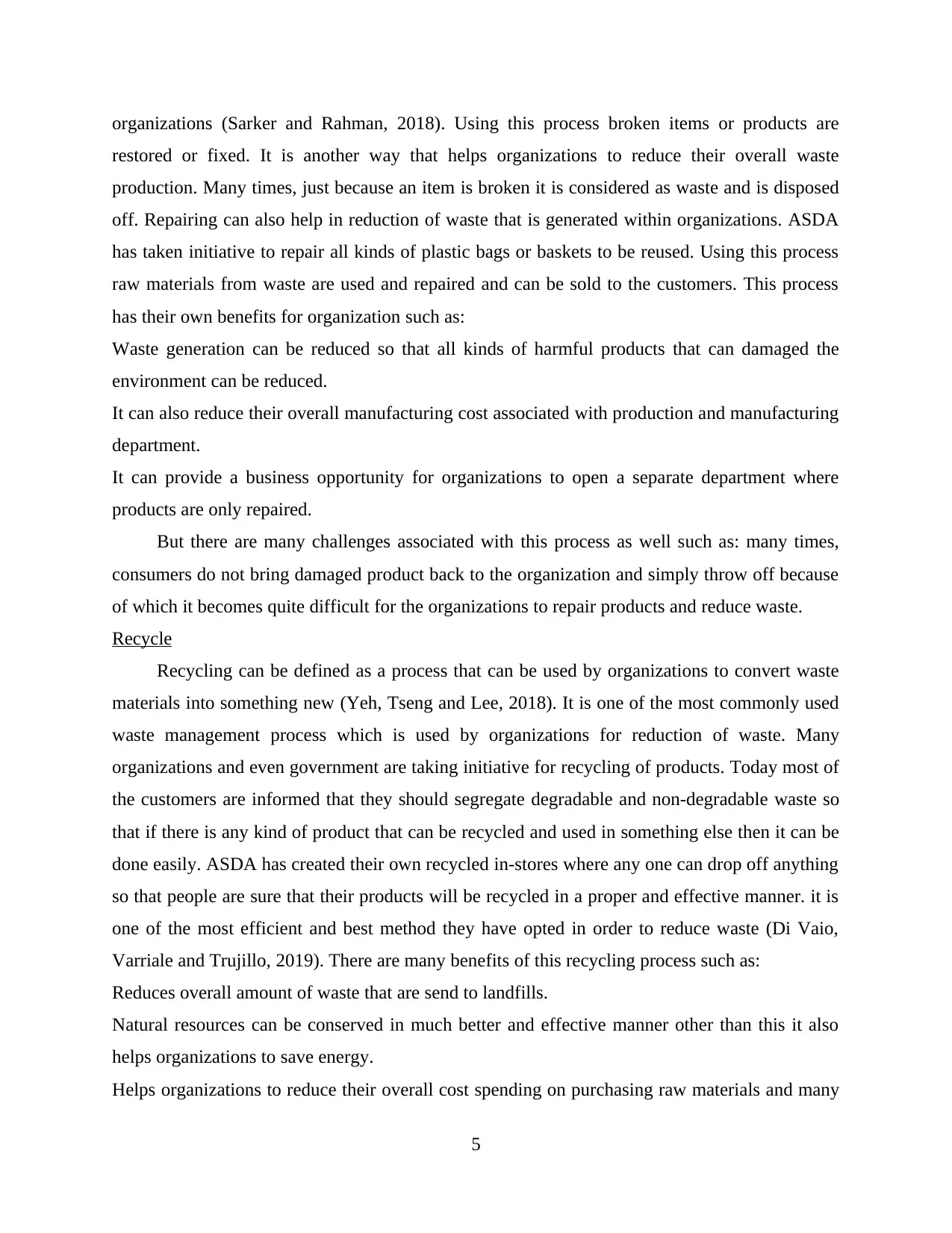
organizations (Sarker and Rahman, 2018). Using this process broken items or products are
restored or fixed. It is another way that helps organizations to reduce their overall waste
production. Many times, just because an item is broken it is considered as waste and is disposed
off. Repairing can also help in reduction of waste that is generated within organizations. ASDA
has taken initiative to repair all kinds of plastic bags or baskets to be reused. Using this process
raw materials from waste are used and repaired and can be sold to the customers. This process
has their own benefits for organization such as:
Waste generation can be reduced so that all kinds of harmful products that can damaged the
environment can be reduced.
It can also reduce their overall manufacturing cost associated with production and manufacturing
department.
It can provide a business opportunity for organizations to open a separate department where
products are only repaired.
But there are many challenges associated with this process as well such as: many times,
consumers do not bring damaged product back to the organization and simply throw off because
of which it becomes quite difficult for the organizations to repair products and reduce waste.
Recycle
Recycling can be defined as a process that can be used by organizations to convert waste
materials into something new (Yeh, Tseng and Lee, 2018). It is one of the most commonly used
waste management process which is used by organizations for reduction of waste. Many
organizations and even government are taking initiative for recycling of products. Today most of
the customers are informed that they should segregate degradable and non-degradable waste so
that if there is any kind of product that can be recycled and used in something else then it can be
done easily. ASDA has created their own recycled in-stores where any one can drop off anything
so that people are sure that their products will be recycled in a proper and effective manner. it is
one of the most efficient and best method they have opted in order to reduce waste (Di Vaio,
Varriale and Trujillo, 2019). There are many benefits of this recycling process such as:
Reduces overall amount of waste that are send to landfills.
Natural resources can be conserved in much better and effective manner other than this it also
helps organizations to save energy.
Helps organizations to reduce their overall cost spending on purchasing raw materials and many
5
restored or fixed. It is another way that helps organizations to reduce their overall waste
production. Many times, just because an item is broken it is considered as waste and is disposed
off. Repairing can also help in reduction of waste that is generated within organizations. ASDA
has taken initiative to repair all kinds of plastic bags or baskets to be reused. Using this process
raw materials from waste are used and repaired and can be sold to the customers. This process
has their own benefits for organization such as:
Waste generation can be reduced so that all kinds of harmful products that can damaged the
environment can be reduced.
It can also reduce their overall manufacturing cost associated with production and manufacturing
department.
It can provide a business opportunity for organizations to open a separate department where
products are only repaired.
But there are many challenges associated with this process as well such as: many times,
consumers do not bring damaged product back to the organization and simply throw off because
of which it becomes quite difficult for the organizations to repair products and reduce waste.
Recycle
Recycling can be defined as a process that can be used by organizations to convert waste
materials into something new (Yeh, Tseng and Lee, 2018). It is one of the most commonly used
waste management process which is used by organizations for reduction of waste. Many
organizations and even government are taking initiative for recycling of products. Today most of
the customers are informed that they should segregate degradable and non-degradable waste so
that if there is any kind of product that can be recycled and used in something else then it can be
done easily. ASDA has created their own recycled in-stores where any one can drop off anything
so that people are sure that their products will be recycled in a proper and effective manner. it is
one of the most efficient and best method they have opted in order to reduce waste (Di Vaio,
Varriale and Trujillo, 2019). There are many benefits of this recycling process such as:
Reduces overall amount of waste that are send to landfills.
Natural resources can be conserved in much better and effective manner other than this it also
helps organizations to save energy.
Helps organizations to reduce their overall cost spending on purchasing raw materials and many
5
Paraphrase This Document
Need a fresh take? Get an instant paraphrase of this document with our AI Paraphraser
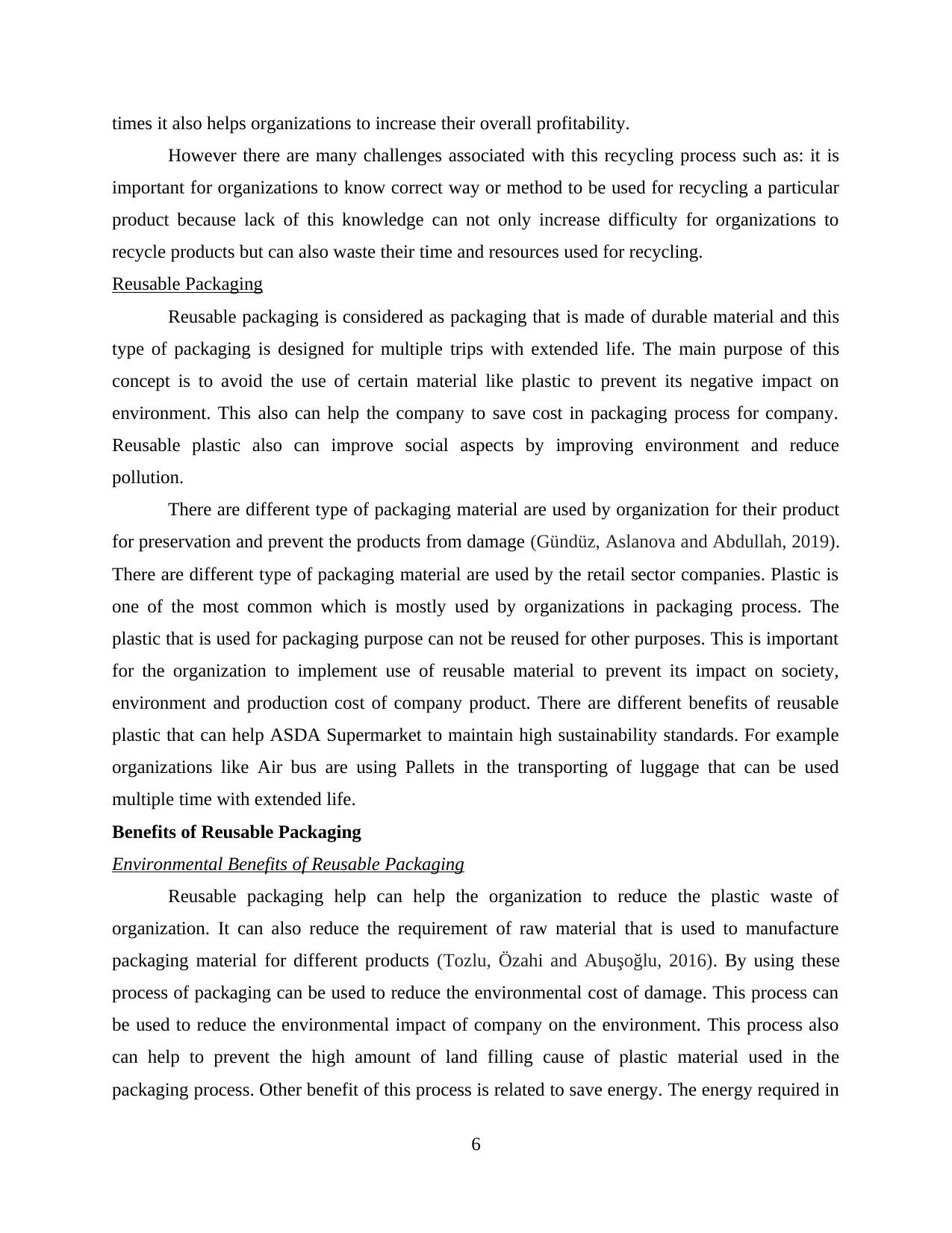
times it also helps organizations to increase their overall profitability.
However there are many challenges associated with this recycling process such as: it is
important for organizations to know correct way or method to be used for recycling a particular
product because lack of this knowledge can not only increase difficulty for organizations to
recycle products but can also waste their time and resources used for recycling.
Reusable Packaging
Reusable packaging is considered as packaging that is made of durable material and this
type of packaging is designed for multiple trips with extended life. The main purpose of this
concept is to avoid the use of certain material like plastic to prevent its negative impact on
environment. This also can help the company to save cost in packaging process for company.
Reusable plastic also can improve social aspects by improving environment and reduce
pollution.
There are different type of packaging material are used by organization for their product
for preservation and prevent the products from damage (Gündüz, Aslanova and Abdullah, 2019).
There are different type of packaging material are used by the retail sector companies. Plastic is
one of the most common which is mostly used by organizations in packaging process. The
plastic that is used for packaging purpose can not be reused for other purposes. This is important
for the organization to implement use of reusable material to prevent its impact on society,
environment and production cost of company product. There are different benefits of reusable
plastic that can help ASDA Supermarket to maintain high sustainability standards. For example
organizations like Air bus are using Pallets in the transporting of luggage that can be used
multiple time with extended life.
Benefits of Reusable Packaging
Environmental Benefits of Reusable Packaging
Reusable packaging help can help the organization to reduce the plastic waste of
organization. It can also reduce the requirement of raw material that is used to manufacture
packaging material for different products (Tozlu, Özahi and Abuşoğlu, 2016). By using these
process of packaging can be used to reduce the environmental cost of damage. This process can
be used to reduce the environmental impact of company on the environment. This process also
can help to prevent the high amount of land filling cause of plastic material used in the
packaging process. Other benefit of this process is related to save energy. The energy required in
6
However there are many challenges associated with this recycling process such as: it is
important for organizations to know correct way or method to be used for recycling a particular
product because lack of this knowledge can not only increase difficulty for organizations to
recycle products but can also waste their time and resources used for recycling.
Reusable Packaging
Reusable packaging is considered as packaging that is made of durable material and this
type of packaging is designed for multiple trips with extended life. The main purpose of this
concept is to avoid the use of certain material like plastic to prevent its negative impact on
environment. This also can help the company to save cost in packaging process for company.
Reusable plastic also can improve social aspects by improving environment and reduce
pollution.
There are different type of packaging material are used by organization for their product
for preservation and prevent the products from damage (Gündüz, Aslanova and Abdullah, 2019).
There are different type of packaging material are used by the retail sector companies. Plastic is
one of the most common which is mostly used by organizations in packaging process. The
plastic that is used for packaging purpose can not be reused for other purposes. This is important
for the organization to implement use of reusable material to prevent its impact on society,
environment and production cost of company product. There are different benefits of reusable
plastic that can help ASDA Supermarket to maintain high sustainability standards. For example
organizations like Air bus are using Pallets in the transporting of luggage that can be used
multiple time with extended life.
Benefits of Reusable Packaging
Environmental Benefits of Reusable Packaging
Reusable packaging help can help the organization to reduce the plastic waste of
organization. It can also reduce the requirement of raw material that is used to manufacture
packaging material for different products (Tozlu, Özahi and Abuşoğlu, 2016). By using these
process of packaging can be used to reduce the environmental cost of damage. This process can
be used to reduce the environmental impact of company on the environment. This process also
can help to prevent the high amount of land filling cause of plastic material used in the
packaging process. Other benefit of this process is related to save energy. The energy required in
6
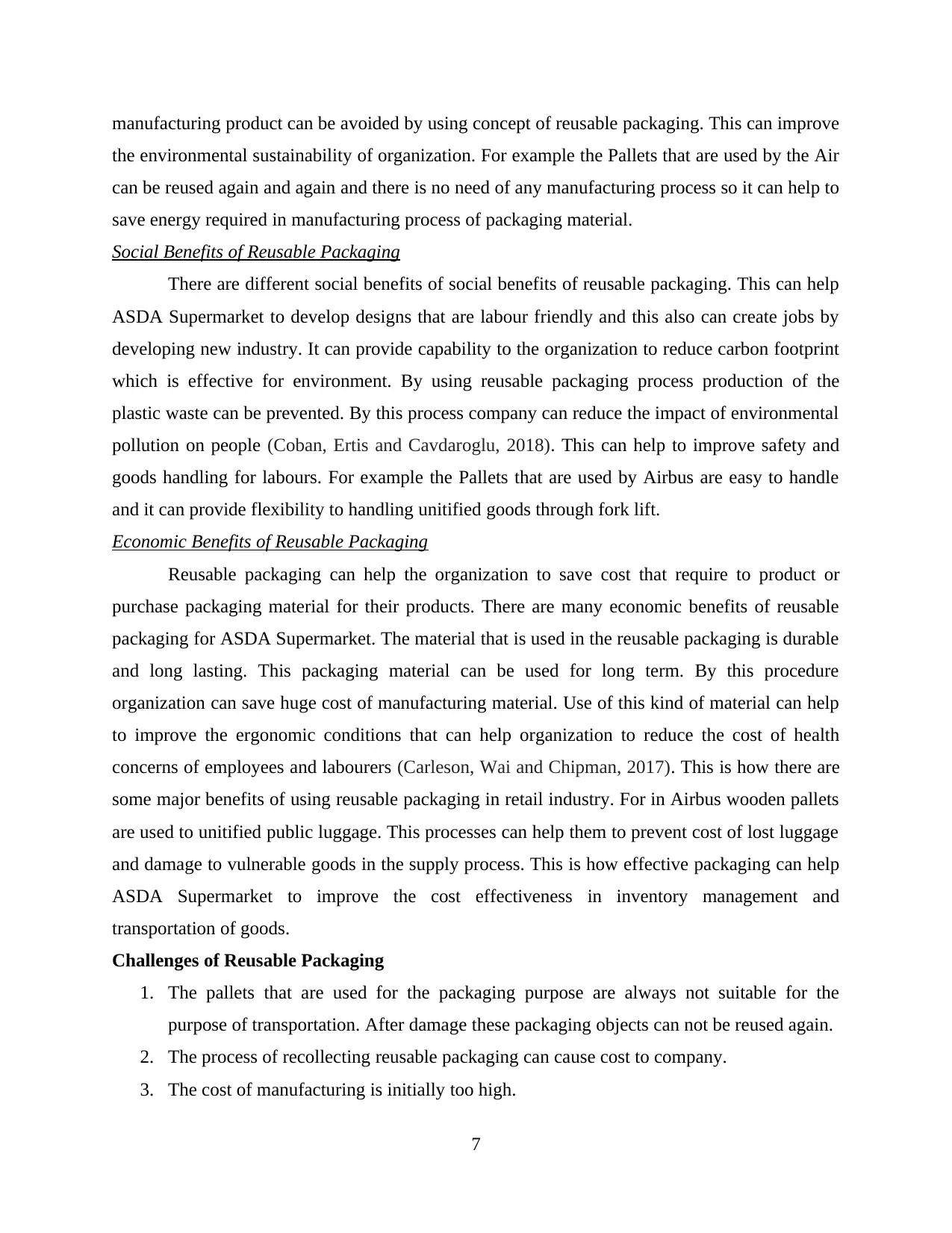
manufacturing product can be avoided by using concept of reusable packaging. This can improve
the environmental sustainability of organization. For example the Pallets that are used by the Air
can be reused again and again and there is no need of any manufacturing process so it can help to
save energy required in manufacturing process of packaging material.
Social Benefits of Reusable Packaging
There are different social benefits of social benefits of reusable packaging. This can help
ASDA Supermarket to develop designs that are labour friendly and this also can create jobs by
developing new industry. It can provide capability to the organization to reduce carbon footprint
which is effective for environment. By using reusable packaging process production of the
plastic waste can be prevented. By this process company can reduce the impact of environmental
pollution on people (Coban, Ertis and Cavdaroglu, 2018). This can help to improve safety and
goods handling for labours. For example the Pallets that are used by Airbus are easy to handle
and it can provide flexibility to handling unitified goods through fork lift.
Economic Benefits of Reusable Packaging
Reusable packaging can help the organization to save cost that require to product or
purchase packaging material for their products. There are many economic benefits of reusable
packaging for ASDA Supermarket. The material that is used in the reusable packaging is durable
and long lasting. This packaging material can be used for long term. By this procedure
organization can save huge cost of manufacturing material. Use of this kind of material can help
to improve the ergonomic conditions that can help organization to reduce the cost of health
concerns of employees and labourers (Carleson, Wai and Chipman, 2017). This is how there are
some major benefits of using reusable packaging in retail industry. For in Airbus wooden pallets
are used to unitified public luggage. This processes can help them to prevent cost of lost luggage
and damage to vulnerable goods in the supply process. This is how effective packaging can help
ASDA Supermarket to improve the cost effectiveness in inventory management and
transportation of goods.
Challenges of Reusable Packaging
1. The pallets that are used for the packaging purpose are always not suitable for the
purpose of transportation. After damage these packaging objects can not be reused again.
2. The process of recollecting reusable packaging can cause cost to company.
3. The cost of manufacturing is initially too high.
7
the environmental sustainability of organization. For example the Pallets that are used by the Air
can be reused again and again and there is no need of any manufacturing process so it can help to
save energy required in manufacturing process of packaging material.
Social Benefits of Reusable Packaging
There are different social benefits of social benefits of reusable packaging. This can help
ASDA Supermarket to develop designs that are labour friendly and this also can create jobs by
developing new industry. It can provide capability to the organization to reduce carbon footprint
which is effective for environment. By using reusable packaging process production of the
plastic waste can be prevented. By this process company can reduce the impact of environmental
pollution on people (Coban, Ertis and Cavdaroglu, 2018). This can help to improve safety and
goods handling for labours. For example the Pallets that are used by Airbus are easy to handle
and it can provide flexibility to handling unitified goods through fork lift.
Economic Benefits of Reusable Packaging
Reusable packaging can help the organization to save cost that require to product or
purchase packaging material for their products. There are many economic benefits of reusable
packaging for ASDA Supermarket. The material that is used in the reusable packaging is durable
and long lasting. This packaging material can be used for long term. By this procedure
organization can save huge cost of manufacturing material. Use of this kind of material can help
to improve the ergonomic conditions that can help organization to reduce the cost of health
concerns of employees and labourers (Carleson, Wai and Chipman, 2017). This is how there are
some major benefits of using reusable packaging in retail industry. For in Airbus wooden pallets
are used to unitified public luggage. This processes can help them to prevent cost of lost luggage
and damage to vulnerable goods in the supply process. This is how effective packaging can help
ASDA Supermarket to improve the cost effectiveness in inventory management and
transportation of goods.
Challenges of Reusable Packaging
1. The pallets that are used for the packaging purpose are always not suitable for the
purpose of transportation. After damage these packaging objects can not be reused again.
2. The process of recollecting reusable packaging can cause cost to company.
3. The cost of manufacturing is initially too high.
7
⊘ This is a preview!⊘
Do you want full access?
Subscribe today to unlock all pages.

Trusted by 1+ million students worldwide
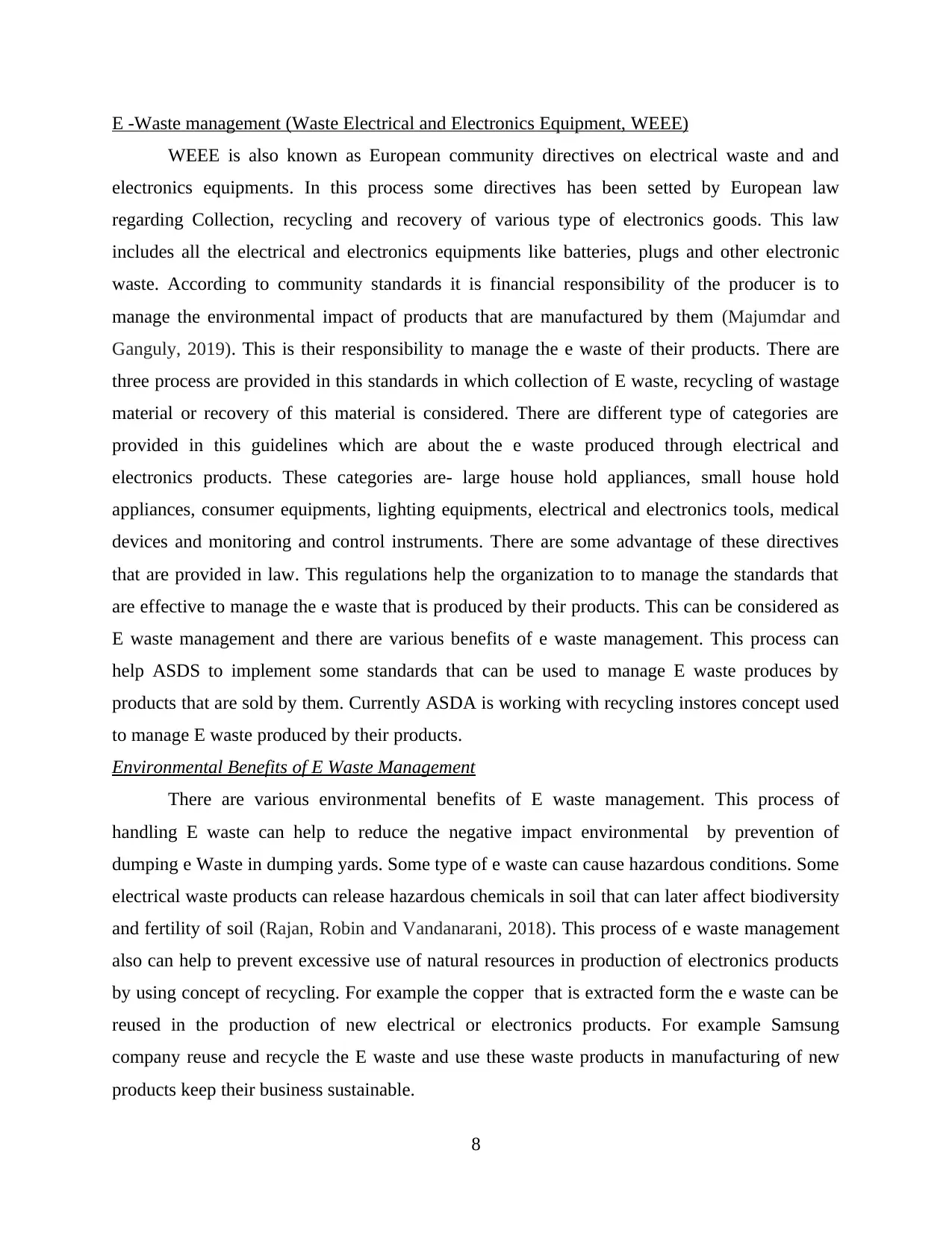
E -Waste management (Waste Electrical and Electronics Equipment, WEEE)
WEEE is also known as European community directives on electrical waste and and
electronics equipments. In this process some directives has been setted by European law
regarding Collection, recycling and recovery of various type of electronics goods. This law
includes all the electrical and electronics equipments like batteries, plugs and other electronic
waste. According to community standards it is financial responsibility of the producer is to
manage the environmental impact of products that are manufactured by them (Majumdar and
Ganguly, 2019). This is their responsibility to manage the e waste of their products. There are
three process are provided in this standards in which collection of E waste, recycling of wastage
material or recovery of this material is considered. There are different type of categories are
provided in this guidelines which are about the e waste produced through electrical and
electronics products. These categories are- large house hold appliances, small house hold
appliances, consumer equipments, lighting equipments, electrical and electronics tools, medical
devices and monitoring and control instruments. There are some advantage of these directives
that are provided in law. This regulations help the organization to to manage the standards that
are effective to manage the e waste that is produced by their products. This can be considered as
E waste management and there are various benefits of e waste management. This process can
help ASDS to implement some standards that can be used to manage E waste produces by
products that are sold by them. Currently ASDA is working with recycling instores concept used
to manage E waste produced by their products.
Environmental Benefits of E Waste Management
There are various environmental benefits of E waste management. This process of
handling E waste can help to reduce the negative impact environmental by prevention of
dumping e Waste in dumping yards. Some type of e waste can cause hazardous conditions. Some
electrical waste products can release hazardous chemicals in soil that can later affect biodiversity
and fertility of soil (Rajan, Robin and Vandanarani, 2018). This process of e waste management
also can help to prevent excessive use of natural resources in production of electronics products
by using concept of recycling. For example the copper that is extracted form the e waste can be
reused in the production of new electrical or electronics products. For example Samsung
company reuse and recycle the E waste and use these waste products in manufacturing of new
products keep their business sustainable.
8
WEEE is also known as European community directives on electrical waste and and
electronics equipments. In this process some directives has been setted by European law
regarding Collection, recycling and recovery of various type of electronics goods. This law
includes all the electrical and electronics equipments like batteries, plugs and other electronic
waste. According to community standards it is financial responsibility of the producer is to
manage the environmental impact of products that are manufactured by them (Majumdar and
Ganguly, 2019). This is their responsibility to manage the e waste of their products. There are
three process are provided in this standards in which collection of E waste, recycling of wastage
material or recovery of this material is considered. There are different type of categories are
provided in this guidelines which are about the e waste produced through electrical and
electronics products. These categories are- large house hold appliances, small house hold
appliances, consumer equipments, lighting equipments, electrical and electronics tools, medical
devices and monitoring and control instruments. There are some advantage of these directives
that are provided in law. This regulations help the organization to to manage the standards that
are effective to manage the e waste that is produced by their products. This can be considered as
E waste management and there are various benefits of e waste management. This process can
help ASDS to implement some standards that can be used to manage E waste produces by
products that are sold by them. Currently ASDA is working with recycling instores concept used
to manage E waste produced by their products.
Environmental Benefits of E Waste Management
There are various environmental benefits of E waste management. This process of
handling E waste can help to reduce the negative impact environmental by prevention of
dumping e Waste in dumping yards. Some type of e waste can cause hazardous conditions. Some
electrical waste products can release hazardous chemicals in soil that can later affect biodiversity
and fertility of soil (Rajan, Robin and Vandanarani, 2018). This process of e waste management
also can help to prevent excessive use of natural resources in production of electronics products
by using concept of recycling. For example the copper that is extracted form the e waste can be
reused in the production of new electrical or electronics products. For example Samsung
company reuse and recycle the E waste and use these waste products in manufacturing of new
products keep their business sustainable.
8
Paraphrase This Document
Need a fresh take? Get an instant paraphrase of this document with our AI Paraphraser
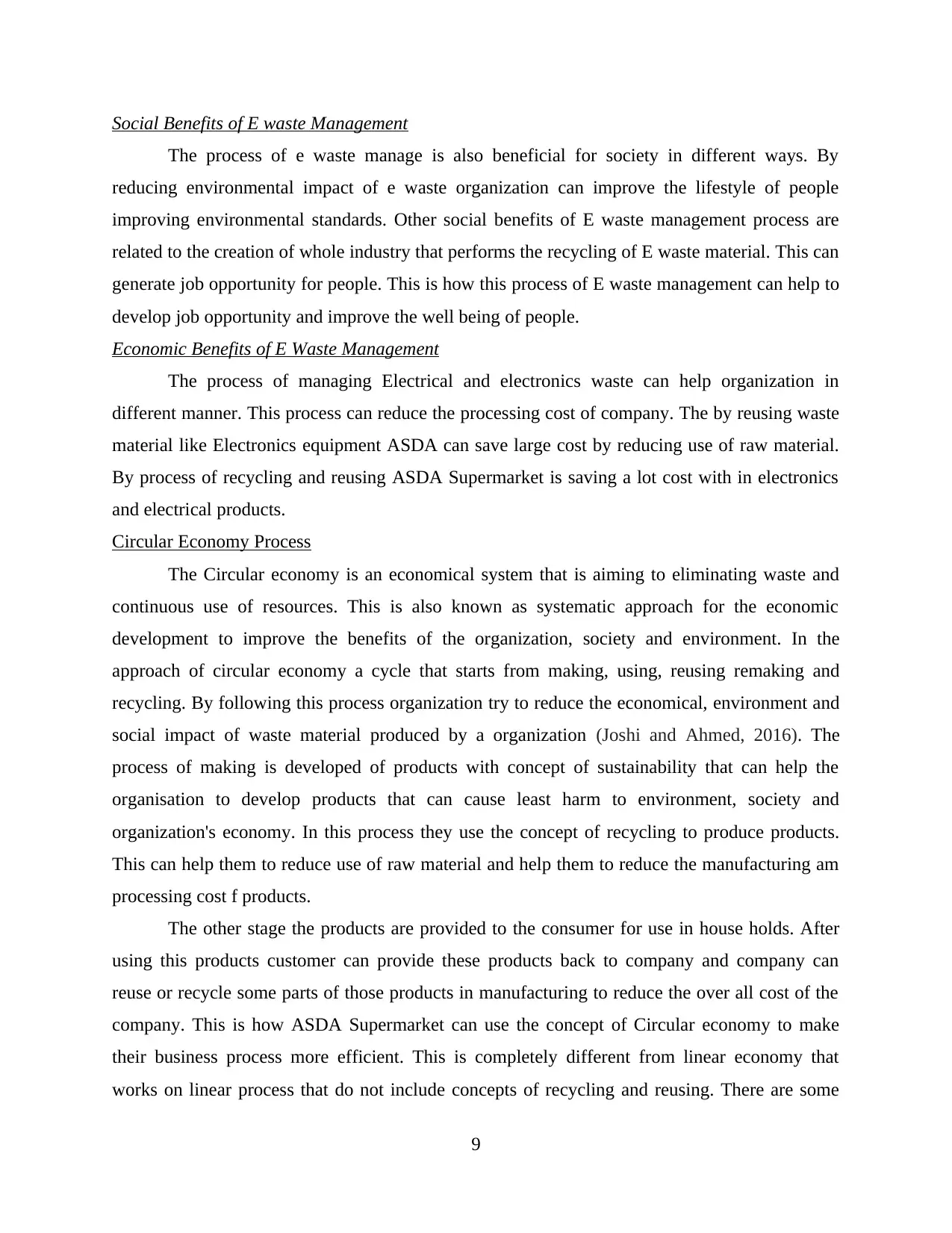
Social Benefits of E waste Management
The process of e waste manage is also beneficial for society in different ways. By
reducing environmental impact of e waste organization can improve the lifestyle of people
improving environmental standards. Other social benefits of E waste management process are
related to the creation of whole industry that performs the recycling of E waste material. This can
generate job opportunity for people. This is how this process of E waste management can help to
develop job opportunity and improve the well being of people.
Economic Benefits of E Waste Management
The process of managing Electrical and electronics waste can help organization in
different manner. This process can reduce the processing cost of company. The by reusing waste
material like Electronics equipment ASDA can save large cost by reducing use of raw material.
By process of recycling and reusing ASDA Supermarket is saving a lot cost with in electronics
and electrical products.
Circular Economy Process
The Circular economy is an economical system that is aiming to eliminating waste and
continuous use of resources. This is also known as systematic approach for the economic
development to improve the benefits of the organization, society and environment. In the
approach of circular economy a cycle that starts from making, using, reusing remaking and
recycling. By following this process organization try to reduce the economical, environment and
social impact of waste material produced by a organization (Joshi and Ahmed, 2016). The
process of making is developed of products with concept of sustainability that can help the
organisation to develop products that can cause least harm to environment, society and
organization's economy. In this process they use the concept of recycling to produce products.
This can help them to reduce use of raw material and help them to reduce the manufacturing am
processing cost f products.
The other stage the products are provided to the consumer for use in house holds. After
using this products customer can provide these products back to company and company can
reuse or recycle some parts of those products in manufacturing to reduce the over all cost of the
company. This is how ASDA Supermarket can use the concept of Circular economy to make
their business process more efficient. This is completely different from linear economy that
works on linear process that do not include concepts of recycling and reusing. There are some
9
The process of e waste manage is also beneficial for society in different ways. By
reducing environmental impact of e waste organization can improve the lifestyle of people
improving environmental standards. Other social benefits of E waste management process are
related to the creation of whole industry that performs the recycling of E waste material. This can
generate job opportunity for people. This is how this process of E waste management can help to
develop job opportunity and improve the well being of people.
Economic Benefits of E Waste Management
The process of managing Electrical and electronics waste can help organization in
different manner. This process can reduce the processing cost of company. The by reusing waste
material like Electronics equipment ASDA can save large cost by reducing use of raw material.
By process of recycling and reusing ASDA Supermarket is saving a lot cost with in electronics
and electrical products.
Circular Economy Process
The Circular economy is an economical system that is aiming to eliminating waste and
continuous use of resources. This is also known as systematic approach for the economic
development to improve the benefits of the organization, society and environment. In the
approach of circular economy a cycle that starts from making, using, reusing remaking and
recycling. By following this process organization try to reduce the economical, environment and
social impact of waste material produced by a organization (Joshi and Ahmed, 2016). The
process of making is developed of products with concept of sustainability that can help the
organisation to develop products that can cause least harm to environment, society and
organization's economy. In this process they use the concept of recycling to produce products.
This can help them to reduce use of raw material and help them to reduce the manufacturing am
processing cost f products.
The other stage the products are provided to the consumer for use in house holds. After
using this products customer can provide these products back to company and company can
reuse or recycle some parts of those products in manufacturing to reduce the over all cost of the
company. This is how ASDA Supermarket can use the concept of Circular economy to make
their business process more efficient. This is completely different from linear economy that
works on linear process that do not include concepts of recycling and reusing. There are some
9
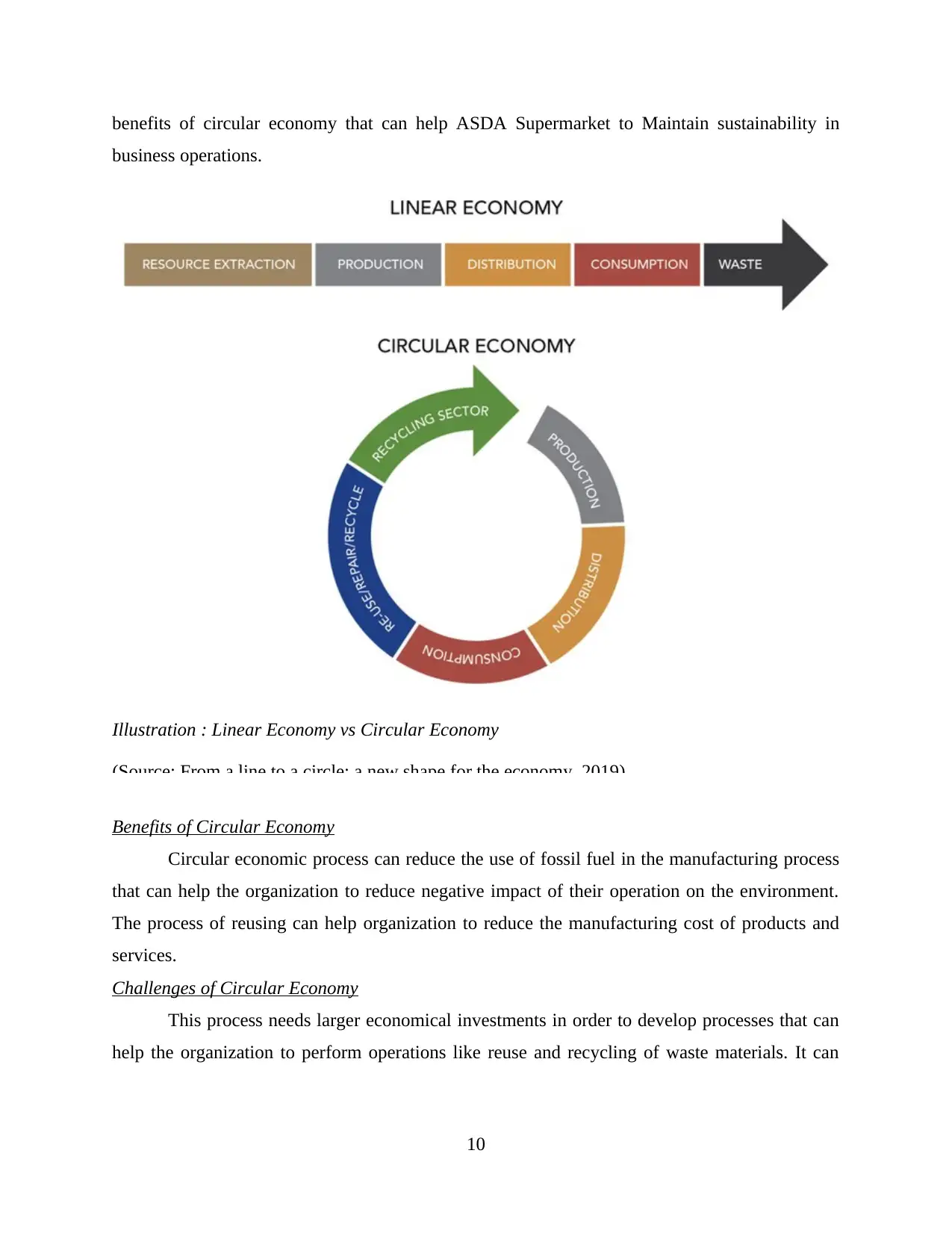
benefits of circular economy that can help ASDA Supermarket to Maintain sustainability in
business operations.
Benefits of Circular Economy
Circular economic process can reduce the use of fossil fuel in the manufacturing process
that can help the organization to reduce negative impact of their operation on the environment.
The process of reusing can help organization to reduce the manufacturing cost of products and
services.
Challenges of Circular Economy
This process needs larger economical investments in order to develop processes that can
help the organization to perform operations like reuse and recycling of waste materials. It can
10
Illustration : Linear Economy vs Circular Economy
(Source: From a line to a circle: a new shape for the economy, 2019)
business operations.
Benefits of Circular Economy
Circular economic process can reduce the use of fossil fuel in the manufacturing process
that can help the organization to reduce negative impact of their operation on the environment.
The process of reusing can help organization to reduce the manufacturing cost of products and
services.
Challenges of Circular Economy
This process needs larger economical investments in order to develop processes that can
help the organization to perform operations like reuse and recycling of waste materials. It can
10
Illustration : Linear Economy vs Circular Economy
(Source: From a line to a circle: a new shape for the economy, 2019)
⊘ This is a preview!⊘
Do you want full access?
Subscribe today to unlock all pages.

Trusted by 1+ million students worldwide
1 out of 15
Related Documents
Your All-in-One AI-Powered Toolkit for Academic Success.
+13062052269
info@desklib.com
Available 24*7 on WhatsApp / Email
![[object Object]](/_next/static/media/star-bottom.7253800d.svg)
Unlock your academic potential
Copyright © 2020–2025 A2Z Services. All Rights Reserved. Developed and managed by ZUCOL.




